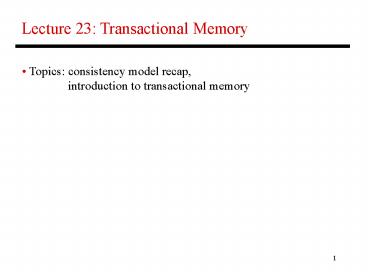Lecture 23: Transactional Memory - PowerPoint PPT Presentation
Title:
Lecture 23: Transactional Memory
Description:
Lecture 23: Transactional Memory Topics: consistency model recap, introduction to transactional memory * – PowerPoint PPT presentation
Number of Views:87
Avg rating:3.0/5.0
Title: Lecture 23: Transactional Memory
1
Lecture 23 Transactional Memory
- Topics consistency model recap,
- introduction to transactional
memory
2
Example Programs
Initially, A B 0 P1
P2 A 1 B
1 if (B 0) if (A 0)
critical section critical
section Initially, A B 0 P1
P2 P3 A 1
if (A 1) B 1
if (B 1)
register A
P1 P2 Data 2000
while (Head 0) Head 1
Data
3
Sequential Consistency
P1 P2 Instr-a
Instr-A Instr-b Instr-B
Instr-c Instr-C Instr-d
Instr-D
- We assume
- Within a program, program order is preserved
- Each instruction executes atomically
- Instructions from different threads can be
interleaved arbitrarily - Valid executions
- abAcBCDdeE or ABCDEFabGc or
abcAdBe or - aAbBcCdDeE or ..
4
Sequential Consistency
- A multiprocessor is sequentially consistent if
the result - of the execution is achieveable by maintaining
program - order within a processor and interleaving
accesses by - different processors in an arbitrary fashion
- Can implement sequential consistency by
requiring the - following program order, write serialization,
everyone has - seen an update before a value is read very
intuitive for - the programmer, but extremely slow
- This is very slow alternatives
- Add optimizations to the hardware
- Offer a relaxed memory consistency model and
fences
5
Fences
P1
P2
Region of code Region
of code with no races
with no races
Fence
Fence Acquire_lock
Acquire_lock Fence
Fence
Racy code
Racy code
Fence
Fence Release_lock
Release_lock Fence
Fence
6
Transactions
- New paradigm to simplify programming
- instead of lock-unlock, use transaction
begin-end - locks are blocking, transactions execute
speculative - in the hope that there will be no conflicts
- Can yield better performance Eliminates
deadlocks - Programmer can freely encapsulate code sections
within - transactions and not worry about the impact on
- performance and correctness (for the most
part) - Programmer specifies the code sections theyd
like to see - execute atomically the hardware takes care of
the rest - (provides illusion of atomicity)
7
Transactions
- Transactional semantics
- when a transaction executes, it is as if the
rest of the - system is suspended and the transaction is in
isolation - the reads and writes of a transaction happen as
if they - are all a single atomic operation
- if the above conditions are not met, the
transaction - fails to commit (abort) and tries again
- transaction begin
- read shared variables
- arithmetic
- write shared variables
- transaction end
8
Example 1
lock (lock1) counter
counter 1 unlock (lock1) transaction
begin counter counter 1 transaction
end No apparent advantage to using transactions
(apart from fault resiliency)
9
Example 2
Producer-consumer relationships producers place
tasks at the tail of a work-queue and consumers
pull tasks out of the head Enqueue
Dequeue transaction
begin transaction
begin if (tail NULL)
if (head-gtnext NULL) update
head and tail update head
and tail else
else update tail
update head
transaction end
transaction end With locks, neither thread can
proceed in parallel since head/tail may be
updated with transactions, enqueue and dequeue
can proceed in parallel transactions will be
aborted only if the queue is nearly empty
10
Example 3
Hash table implementation transaction begin
index hash(key) head bucketindex
traverse linked list until key matches
perform operations transaction end Most
operations will likely not conflict ?
transactions proceed in parallel Coarse-grain
lock ? serialize all operations Fine-grained
locks (one for each bucket) ? more complexity,
more storage,
concurrent
reads not allowed,
concurrent writes to
different elements not allowed
11
TM Implementation
Core
Core
Cache
Cache
- Caches track read-sets and write-sets
- Writes are made visible only at the end of the
transaction - At transaction commit, make your writes visible
others may abort
12
Detecting Conflicts Basic Implementation
- Writes can be cached (cant be written to
memory) if the - block needs to be evicted, flag an overflow
(abort transaction - for now) on an abort, invalidate the written
cache lines - Keep track of read-set and write-set (bits in
the cache) for - each transaction
- When another transaction commits, compare its
write set - with your own read set a match causes an
abort - At transaction end, express intent to commit,
broadcast - write-set (transactions can commit in parallel
if their - write-sets do not intersect)
13
Summary of TM Benefits
- As easy to program as coarse-grain locks
- Performance similar to fine-grain locks
- Speculative parallelization
- Avoids deadlock
- Resilient to faults
14
Design Space
- Data Versioning
- Eager based on an undo log
- Lazy based on a write buffer
- Conflict Detection
- Optimistic detection check for conflicts at
commit time - (proceed optimistically thru transaction)
- Pessimistic detection every read/write checks
for - conflicts (reduces work during commit)
15
Relation to LL-SC
- Transactions can be viewed as an extension of
LL-SC - LL-SC ensures that the read-modify-write for a
single - variable is atomic a transaction ensures
atomicity for all - variables accessed between trans-begin and
trans-end - Vers-1 Vers-2 Vers-3
- ll a ll a trans-begin
- ld b ll b ld a
- st b sc b ld b
- sc a sc a st b
- st a
- trans-end
16
Title
- Bullet































